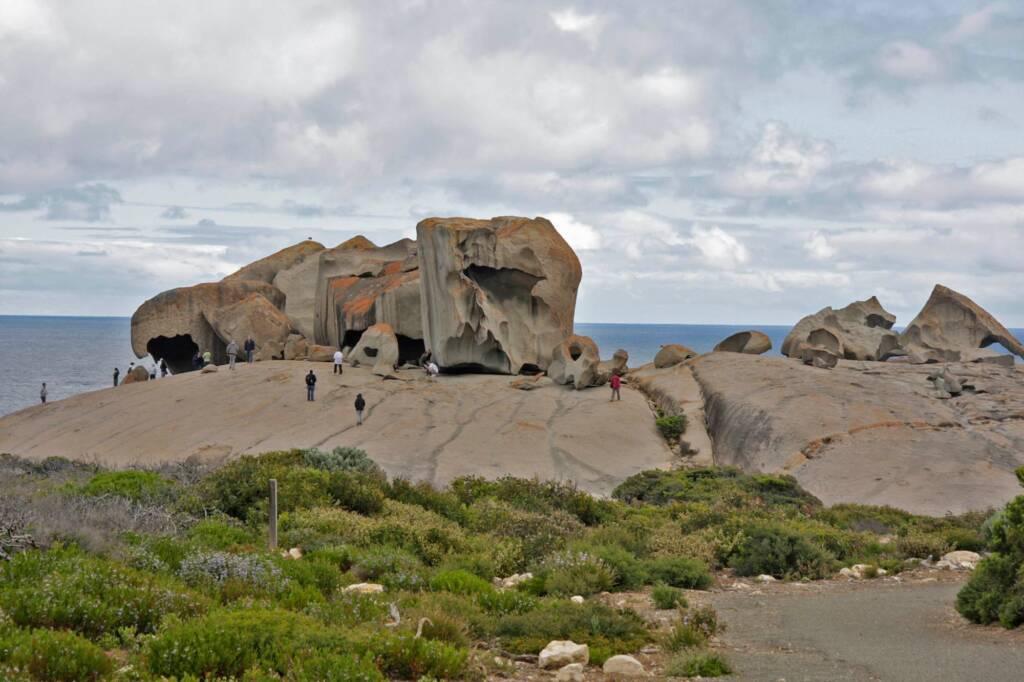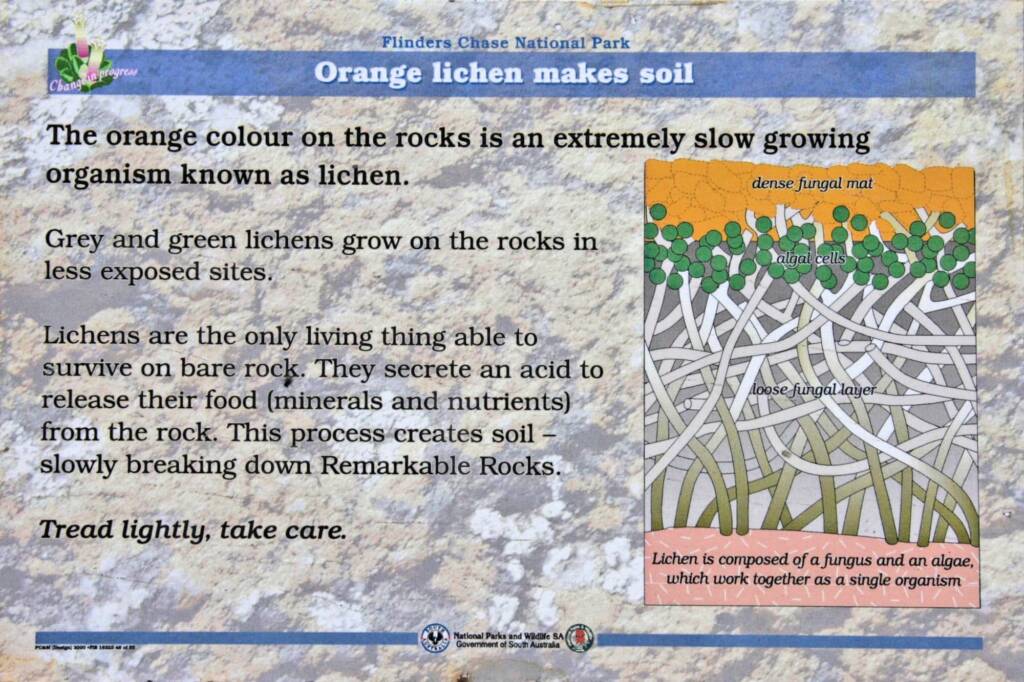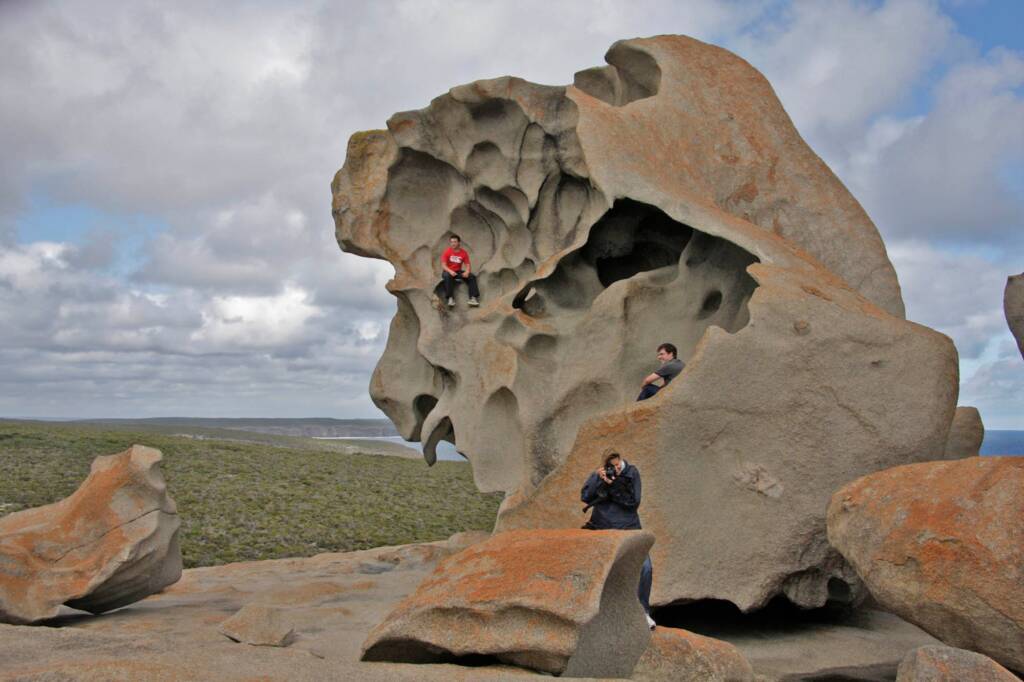Kangaroo IslandKangaroo Island Attractions Fauna Flora Remarkable Rocks
No Kangaroo Island holiday would be complete without a trek to one of the island’s signature landmarks, Remarkable Rocks. It took 500 million years for rain, wind, and pounding waves to create these aptly named granite boulders which are now part of the Flinders Chase National Park.

Remarkable Rocks offers the opportunity for stunning photographs of these “remarkable” sculptures.
Many of the rocks are covered by golden orange lichen, and interpretation signs describe even more details about the formation of the rocks.

Orange lichen makes soil
The orange colour on the rocks is an extremely slow growing organism known as lichen. Grey and green lichens grow on the rocks in less exposed sites.
Lichens are the only living thing able to survive on bare rock. They secrete an acid to release their food (minerals and nutrients) from the rock. This process creates soil – slowly breaking down Remarkable Rocks.
Tread lightly, take care.
Park signage: Orange lichen makes soil, National Parks and Wildlife SA, Government of South Australia

Look out for the xenoliths…
Captured more than 500 million years ago…
xenoliths are lumps of rock which broke off as the molten rock pushed upward through the overlying rock layers.
The heavier xenoliths became embedded when the molten rock crystallised into granite.
…or signs of where they were caught
Very slowly the granite erodes around the tougher xenolith. Loosened, then freed, it leaves behind a hole.
Park signage: Orange lichen makes soil, National Parks and Wildlife SA, Government of South Australia


What is Tafoni?
Tafoni are ellipsoidal, pan- to bowl-shaped, natural rock cavities. These cavernous weathering features include tiny pits, softball-sized cavities, truck-sized caves, and nested and cellular honeycomb forms. Tafoni typically develop on inclined or vertical surfaces and occur in groups.
Source: What is Tafoni? by Jon Boerman, 1 December 2013, Tasmanian Geographic, https://tasmaniangeographic.com/what-is-tafoni/

Extract: The earliest scenery where the landforms were recognised and termed dates from the last years of the XIX century. Starting from this time, two general terms are usually applied to report the basal or lateral cavities developed in granite rocks. The single word “tafone” (plural “tafoni”) and the compound name of “cavernous weathering form”.
Source: Description_and_nomenclature_of_the_Tafo, Cadernos Lab. Xeolóxico de Laxe Coruña. 2008. Vol. 33, pp. 65 – 82, ISSN: 0213 – 4497


Footnote & References
- Photographs: Remarkable Rocks © Marc Newman
- Remarkable Rocks and Admirals Arch, Flinders Chase National Park and Ravine Des Casoars Wilderness Protection Area, https://www.parks.sa.gov.au/parks/flinders-chase-national-park
- What is Tafoni? by Jon Boerman, 1 December 2013, Tasmanian Geographic, https://tasmaniangeographic.com/what-is-tafoni/
- Description_and_nomenclature_of_the_Tafo, Cadernos Lab. Xeolóxico de Laxe Coruña. 2008. Vol. 33, pp. 65 – 82, ISSN: 0213 – 4497
- Defining tafoni: Re-examining terminological ambiguity for cavernous rock decay phenomena, Authors Kaelin M. Groom (University of Arkansas, USA), Casey D. Allen (University of Colorado Denver, USA), Lisa Mol (Cardiff University, UK, and Oxford University, UK), Thomas R. Paradise (University of Arkansas, USA), Kevin Hall (University of Pretoria, South Africa), Progress in Physical Geography 2015, Vol. 39(6) 775–793, © The Author(s) 2015, Reprints and permission: sagepub.co.uk/journalsPermissions.nav DOI: 10.1177/0309133315605037
